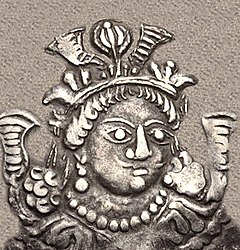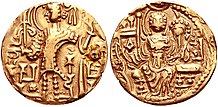
Back Kidara I French Kidara Occitan Quidara Portuguese முதலாம் கிடாரன் Tamil Kidara I Uzbek 寄多罗 Chinese
| Kidara | |
|---|---|
 Portrait of Kidarite king Kidara I, circa 350-386 CE.[1] He wears his characteristic crown with ribbon flying upward. The use of the 3/4 portrait is sometimes attributed to the influence of the coinage of Byzantine ruler Arcadius (377–408 CE).[2] | |
| Kidarites | |
| Reign | c. 350–390 CE |
| Predecessor | Peroz |
| Successor | Uncertain |
"Kushan" coins of Kidara
The word "Kushana" in Brahmi script (

 Ku-shā-ṇa) as it appeared on the bottom left corner of Kidarite coins circa 350 CE.[3]
Ku-shā-ṇa) as it appeared on the bottom left corner of Kidarite coins circa 350 CE.[3]
Kidara I (Late Brahmi script: ![]()
![]()
![]() Ki-da-ra) fl. 350-390 CE) was the first major ruler of the Kidarite Kingdom, which replaced the Indo-Sasanians in northwestern India, in the areas of Kushanshahr, Gandhara, Kashmir and Punjab.[4]
Ki-da-ra) fl. 350-390 CE) was the first major ruler of the Kidarite Kingdom, which replaced the Indo-Sasanians in northwestern India, in the areas of Kushanshahr, Gandhara, Kashmir and Punjab.[4]
- ^ CNG Coins
- ^ Lerner, Judith A. (210). Observations on the Typology and Style of Seals and Sealings from Bactria and the Indo-Iranian Borderlands, in Coins, Art and Chronology II. The First Millennium CE in the Indo-Iranian Borderlands. Vienna: ÖAW. p. 246, note 7.
- ^ Tandon, Pankaj (2009). "An Important New Copper Coin of Gadahara". Journal of the Oriental Numismatic Society (200): 19.
- ^ Cite error: The named reference
HCCE 38was invoked but never defined (see the help page).
© MMXXIII Rich X Search. We shall prevail. All rights reserved. Rich X Search

